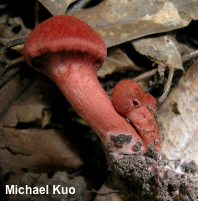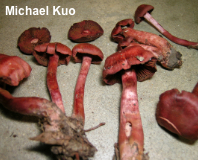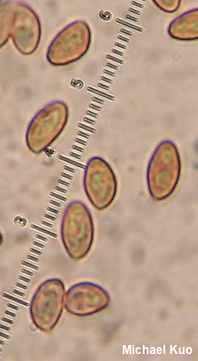| Major Groups > Gilled Mushrooms > Dark-Spored > Cortinarius > Cortinarius marylandensis |

|
Cortinarius marylandensis [Basidiomycota > Agaricales > Cortinariaceae > Cortinarius ... ] by Michael Kuo This beautiful mushroom is one of several small, red species of Cortinarius in North America featuring blood red gills. It can be distinguished from the others on the basis of its association with hardwoods (primarily beech and oaks) in eastern and southeastern North America—and on the basis of the pink to pinkish basal mycelium at the bottom of its stem (another hardwood-associated, similar species, Cortinarius harrisonii has yellow basal mycelium). Other look-alike species are either associated with conifers, western in distribution, or both. See the page for Cortinarius sanguineus for extended comparisons in this species group. Cortinarius hesleri is also similar, but is orange rather than red. Description: Ecology: Mycorrhizal with hardwoods—primarily with beech and oaks; growing alone, scattered, or gregariously; summer and early fall; originally described from Florida, and fairly widely distributed in eastern North America from there to Delaware and Texas, but apparently absent or rare in the upper Midwest; also recently reported from Costa Rica. The illustrated and described collection is from Missouri. Cap: 1–4 cm; convex or bell-shaped at first, becoming broadly bell-shaped, convex, or nearly flat; dry; silky to finely hairy; bright brick red to brownish red, often fading markedly to pale reddish brown; the margin not lined. Gills: Attached to the stem; close; colored like the cap, becoming cinnamon to rusty red; short-gills frequent; when young covered by a pinkish to red cortina. Stem: 2–5 cm long; 0.5–1 cm thick; more or less equal; dry; silky; pale reddish above, colored like the cap below; often darkening to reddish brown near the base or when handled; sometimes with a rusty ring zone; basal mycelium pinkish when fresh. Flesh: Whitish to pale pinkish in cap and upper stem; reddish to brownish in the stem base; unchanging when sliced. Odor: Radishlike, or not distinctive. Chemical Reactions: KOH on cap surface red to purple or black. Spore Print: Rusty brown. Microscopic Features: Spores 6–8 x 3.5–4 µm; ellipsoid or subamygdaliform; finely verrucose. Basidia 25–28 x 5–6 µm; subclavate; 4-sterigmate. Hymenial cystidia not found. Pileipellis a cutis; elements 5–15 µm wide, smooth, hyaline to red-walled in KOH, clamped at septa. Contextual and lamellar elements pinkish purple to purplish red in KOH. REFERENCES: (Ammirati, 1995) Ammirati, Niskanen & Liimatainen, 2013. (Ammirati & Smith, 1984; Weber & Smith, 1985; Metzler & Metzler, 1992; Liu et al., 1995; Niskanen et al., 2013; Elliott & Stephenson, 2018.) Herb. Kuo 09240502. This site contains no information about the edibility or toxicity of mushrooms. |
© MushroomExpert.Com |
|
Cite this page as: Kuo, M. (2022, January). Cortinarius marylandensis. Retrieved from the MushroomExpert.Com Web site: http://www.mushroomexpert.com/cortinarius_marylandensis.html |


